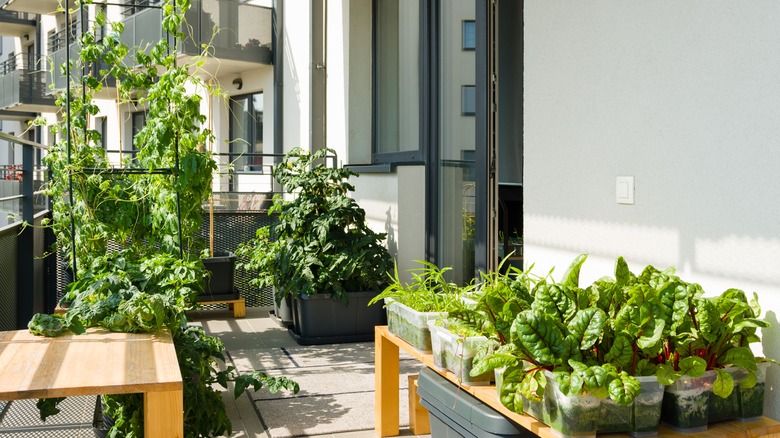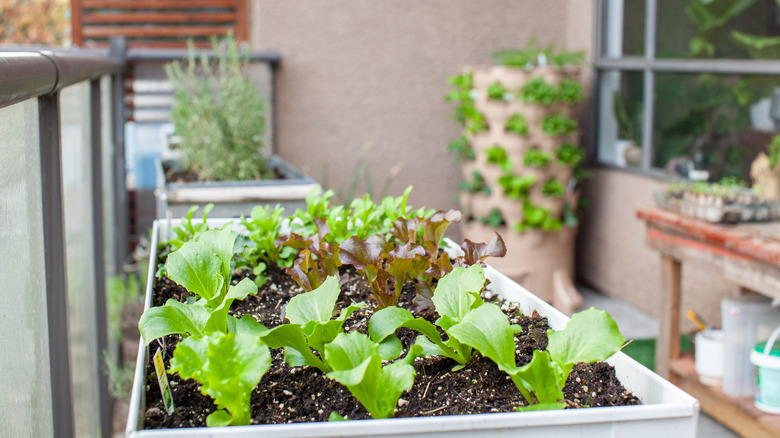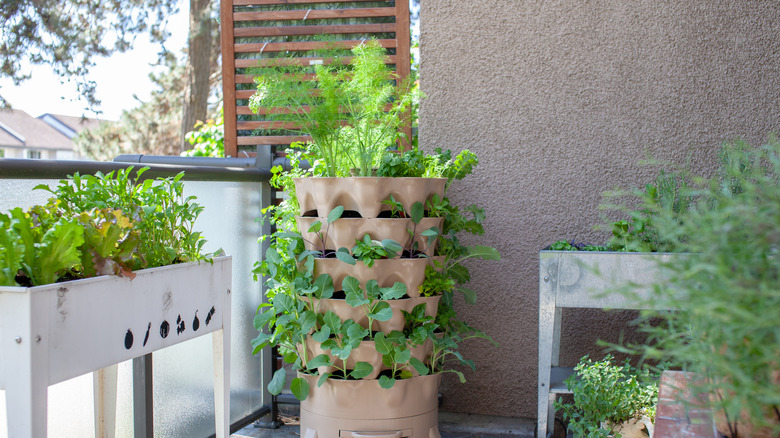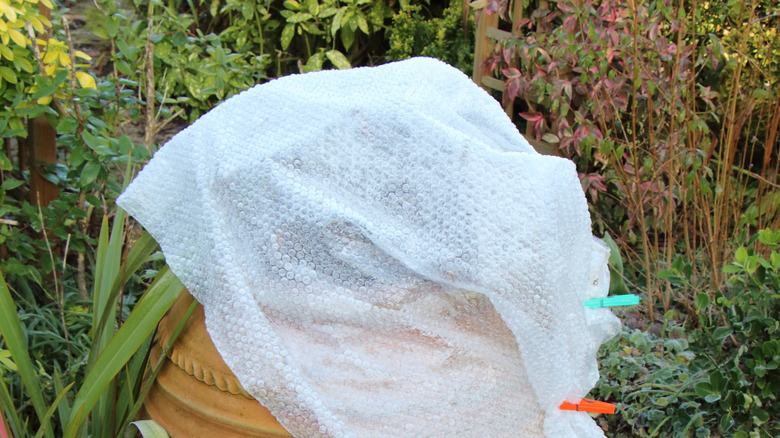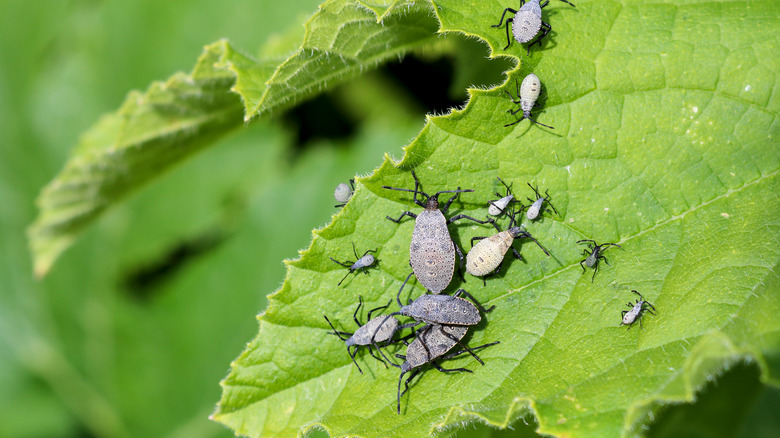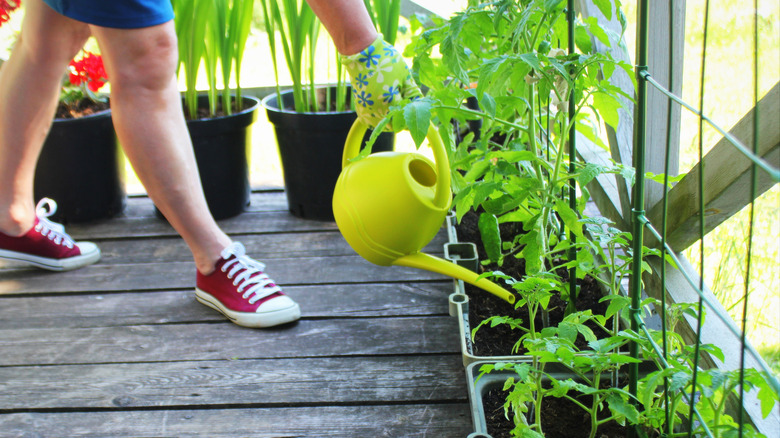5 Benefits Of Growing A Container Garden
When you hear the word garden, you might think of a large patch of lawn with exposed soil tilled into neat rows overflowing with vegetables, but there are many ways to grow your own food. Container gardens are attractive and functional whether you have a sunny balcony or a large yard.
There are a few keys to growing a successful container garden, states Cision PR Newswire. Selecting the right containers for the specific plants you want to grow is vital for them to thrive. A large tomato plant in a 1-gallon container is not going to live long because there is not enough room for its roots. Medium to large plants like squash, tomatoes, and peppers do well in 5-gallon containers. Smaller plants and vines like lettuce and cucumbers have shallower roots and can be grown in 12-inch wide planters. Always make sure the containers you select have good drainage and use high-quality potting soil to help your container garden grow and thrive.
No lawn required
Certainly one of the most appealing aspects of gardening in containers is that you can grow vegetables almost anywhere. Apartment dwellers can still enjoy fresh herbs and veggies if they have a balcony that gets 4 to 8 hours of sun every day, according to Nature Zedge. The kind of plants you select for your balcony should be determined by the amount of sun you get. If your space gets around 4 hours of direct sunlight, but not much more, you will not be able to grow sunlovers like tomatoes and peppers, but there are still plenty of options. Lettuce, onions, peas, and most greens grow well in partial sun.
In areas that get at least 8 hours of sun daily, you can grow almost anything in a container that you could grow in the ground. Thanks to the growing popularity of container gardens, new compact varieties of plants are being developed specifically for small spaces. When you are shopping for plants or seeds, look for labels that use words like "micro" or "mini" in their names or descriptions, like the Micro Tom Tomato.
Minimal weeding
Sometimes weeding can be almost therapeutic, a mindful task that lets you clear your mind as you clear weeds. But usually, weeding is an arduous, undesirable experience you tackle while sweating and swatting at mosquitoes. When you garden in containers, there is less soil surface for weed seeds to sprout, states The Micro Gardener. Less exposed soil means little to no weeding.
You can eliminate the possibility of weeds altogether by mulching around your plant. One or two inches of straw, pine needles, or natural wood mulch not only prevents seeds from sprouting but also helps retain moisture in the container. Since containers dry out more quickly than in-ground gardens, preventing moisture from escaping can save you time and money by not needing to water as frequently (via Miracle-Gro). When selecting mulch for your container garden, use only natural products that have not been treated with chemicals or herbicides, since these products could leech into your soil and damage your plants. Also, if straw is your choice of mulch, be sure you do in fact get straw and not hay since hay still contains seeds that are used to feed livestock.
Easy to protect from frost
Imagine having a large garden that's growing beautifully in the late days of spring and suddenly a cold front arrives with the possibility of frost. Protecting a large area of young seedlings is a lot of work, but if you are growing your plants in containers, there are several easy ways to do this. If you only have a few plants, you can simply bring them indoors until the possibility of frost has passed. If you have several plants or they are too heavy to bring inside, there are other ways to protect them.
Wilson Bros. Gardens recommends wrapping the pot with whatever you have on hand like a blanket or even bubble wrap to protect tender plant roots from the cold. You also need to protect the plant itself. A milk carton or soda bottle with the bottom cut off makes an excellent mini greenhouse that you can cover with a blanket or towel for extra frost protection. You can also create an insulating tent with a few sticks stuck into the middle of the planter covered with plastic. Just make sure that the plastic is not touching the greenery, which can cause frost damage.
Fewer pest and disease problems
Pests and diseases are so frustrating for gardeners. In some instances, your plants can appear perfectly healthy one day, and the next, they're overrun with problems. Since pest eggs, like those laid by squash bugs, overwinter in the soil, they are hard to eradicate without powerful pesticides after they appear. You are less likely to find harmful pests in containers, according to Logan's Garden Shop. If you do discover an unwelcome insect, the issue is easier to manage because you can just separate that container from the others until the problem is resolved.
Fungal and viral issues are also usually a result of infected soil. Blight, a common fungal disease that is detrimental to tomatoes, spreads easily when spores get wet and become airborne (via Garden Tech). Once garden soil is infected, the disease is impossible to eradicate. In the rare instance that a container becomes infected, you can simply replace the soil without worrying about the disease spreading. The same is true for many other soil-borne fungal and viral problems.
Less time spent on maintenance
If you want to grow your own food but do not want to spend a lot of time doing it, container gardening is for you. Sure, you do not have to spend time weeding, and that, in itself, is a reason to grow in containers, but there are other types of maintenance you can avoid. Since smaller plants developed specifically for containers are designed to be compact, you can spend less time managing them as they grow. For example, the typical garden tomato requires pruning and stakes or cages to make sure it can withstand winds and does not outgrow its allotted space. In contrast, some container tomatoes may require a small stake to keep them upright, but most grow as a compact bush, so all you have to do is plant them and watch them grow.
No matter where you grow your veggies, some regular maintenance is required. As a general rule, container plants should be watered any time the soil is dry 1 inch below the surface, and in the hot days of summer, that might be every day. Plants also require fertilization. The University of Maryland Extension recommends feeding container plants about every two weeks with a quick-release water-based fertilizer to enjoy a consistent harvest.
